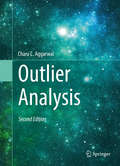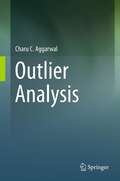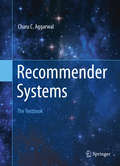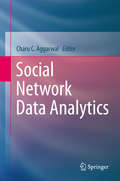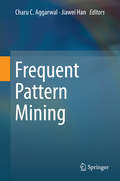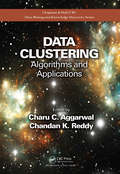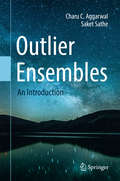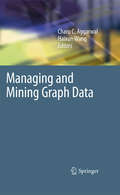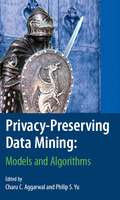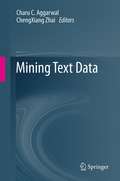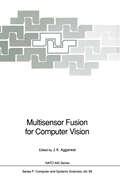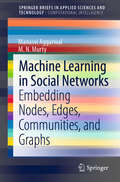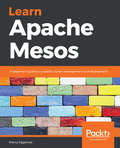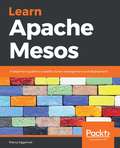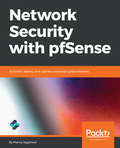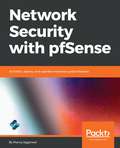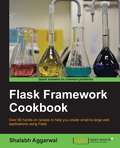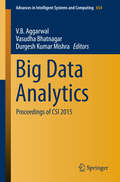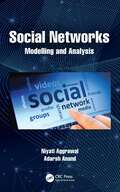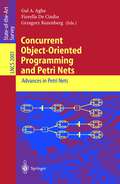- Table View
- List View
Outlier Analysis
by Charu C. AggarwalThis book provides comprehensive coverage of the field of outlier analysis from a computer science point of view. It integrates methods from data mining, machine learning, and statistics within the computational framework and therefore appeals to multiple communities. The chapters of this book can be organized into three categories:Basic algorithms: Chapters 1 through 7 discuss the fundamental algorithms for outlier analysis, including probabilistic and statistical methods, linear methods, proximity-based methods, high-dimensional (subspace) methods, ensemble methods, and supervised methods.Domain-specific methods: Chapters 8 through 12 discuss outlier detection algorithms for various domains of data, such as text, categorical data, time-series data, discrete sequence data, spatial data, and network data.Applications: Chapter 13 is devoted to various applications of outlier analysis. Some guidance is also provided for the practitioner.The second edition of this book is more detailed and is written to appeal to both researchers and practitioners. Significant new material has been added on topics such as kernel methods, one-class support-vector machines, matrix factorization, neural networks, outlier ensembles, time-series methods, and subspace methods. It is written as a textbook and can be used for classroom teaching.
Outlier Analysis
by Charu C. AggarwalWith the increasing advances in hardware technology for data collection, and advances in software technology (databases) for data organization, computer scientists have increasingly participated in the latest advancements of the outlier analysis field. Computer scientists, specifically, approach this field based on their practical experiences in managing large amounts of data, and with far fewer assumptions– the data can be of any type, structured or unstructured, and may be extremely large. Outlier Analysis is a comprehensive exposition, as understood by data mining experts, statisticians and computer scientists. The book has been organized carefully, and emphasis was placed on simplifying the content, so that students and practitioners can also benefit. Chapters will typically cover one of three areas: methods and techniques commonly used in outlier analysis, such as linear methods, proximity-based methods, subspace methods, and supervised methods; data domains, such as, text, categorical, mixed-attribute, time-series, streaming, discrete sequence, spatial and network data; and key applications of these methods as applied to diverse domains such as credit card fraud detection, intrusion detection, medical diagnosis, earth science, web log analytics, and social network analysis are covered.
Recommender Systems: The Textbook
by Charu C. AggarwalThis book comprehensively covers the topic of recommender systems, which provide personalized recommendations of products or services to users based on their previous searches or purchases. Recommender system methods have been adapted to diverse applications including query log mining, social networking, news recommendations, and computational advertising. This book synthesizes both fundamental and advanced topics of a research area that has now reached maturity. The chapters of this book are organized into three categories: Algorithms and evaluation: These chapters discuss the fundamental algorithms in recommender systems, including collaborative filtering methods, content-based methods, knowledge-based methods, ensemble-based methods, and evaluation. Recommendations in specific domains and contexts: the context of a recommendation can be viewed as important side information that affects the recommendation goals. Different types of context such as temporal data, spatial data, social data, tagging data, and trustworthiness are explored. Advanced topics and applications: Various robustness aspects of recommender systems, such as shilling systems, attack models, and their defenses are discussed. In addition, recent topics, such as learning to rank, multi-armed bandits, group systems, multi-criteria systems, and active learning systems, are introduced together with applications. Although this book primarily serves as a textbook, it will also appeal to industrial practitioners and researchers due to its focus on applications and references. Numerous examples and exercises have been provided, and a solution manual is available for instructors.
Social Network Data Analytics
by Charu C. AggarwalSocial network analysis applications have experienced tremendous advances within the last few years due in part to increasing trends towards users interacting with each other on the internet. Social networks are organized as graphs, and the data on social networks takes on the form of massive streams, which are mined for a variety of purposes. Social Network Data Analytics covers an important niche in the social network analytics field. This edited volume, contributed by prominent researchers in this field, presents a wide selection of topics on social network data mining such as Structural Properties of Social Networks, Algorithms for Structural Discovery of Social Networks and Content Analysis in Social Networks. This book is also unique in focussing on the data analytical aspects of social networks in the internet scenario, rather than the traditional sociology-driven emphasis prevalent in the existing books, which do not focus on the unique data-intensive characteristics of online social networks. Emphasis is placed on simplifying the content so that students and practitioners benefit from this book. This book targets advanced level students and researchers concentrating on computer science as a secondary text or reference book. Data mining, database, information security, electronic commerce and machine learning professionals will find this book a valuable asset, as well as primary associations such as ACM, IEEE and Management Science.
Frequent Pattern Mining
by Charu C. Aggarwal Jiawei HanThis comprehensive reference consists of 18 chapters from prominent researchers in the field. Each chapter is self-contained, and synthesizes one aspect of frequent pattern mining. An emphasis is placed on simplifying the content, so that students and practitioners can benefit from the book. Each chapter contains a survey describing key research on the topic, a case study and future directions. Key topics include: Pattern Growth Methods, Frequent Pattern Mining in Data Streams, Mining Graph Patterns, Big Data Frequent Pattern Mining, Algorithms for Data Clustering and more. Advanced-level students in computer science, researchers and practitioners from industry will find this book an invaluable reference.
Data Clustering: Algorithms and Applications (Chapman & Hall/CRC Data Mining and Knowledge Discovery Series)
by Charu C. Aggarwal Chandan K. ReddyResearch on the problem of clustering tends to be fragmented across the pattern recognition, database, data mining, and machine learning communities. Addressing this problem in a unified way, Data Clustering: Algorithms and Applications provides complete coverage of the entire area of clustering, from basic methods to more refined and complex data clustering approaches. It pays special attention to recent issues in graphs, social networks, and other domains.The book focuses on three primary aspects of data clustering: Methods, describing key techniques commonly used for clustering, such as feature selection, agglomerative clustering, partitional clustering, density-based clustering, probabilistic clustering, grid-based clustering, spectral clustering, and nonnegative matrix factorization Domains, covering methods used for different domains of data, such as categorical data, text data, multimedia data, graph data, biological data, stream data, uncertain data, time series clustering, high-dimensional clustering, and big data Variations and Insights, discussing important variations of the clustering process, such as semisupervised clustering, interactive clustering, multiview clustering, cluster ensembles, and cluster validation In this book, top researchers from around the world explore the characteristics of clustering problems in a variety of application areas. They also explain how to glean detailed insight from the clustering process—including how to verify the quality of the underlying clusters—through supervision, human intervention, or the automated generation of alternative clusters.
Data Clustering: Algorithms and Applications (Chapman & Hall/CRC Data Mining and Knowledge Discovery Series #31)
by Charu C. Aggarwal Chandan K. ReddyResearch on the problem of clustering tends to be fragmented across the pattern recognition, database, data mining, and machine learning communities. Addressing this problem in a unified way, Data Clustering: Algorithms and Applications provides complete coverage of the entire area of clustering, from basic methods to more refined and complex data clustering approaches. It pays special attention to recent issues in graphs, social networks, and other domains.The book focuses on three primary aspects of data clustering: Methods, describing key techniques commonly used for clustering, such as feature selection, agglomerative clustering, partitional clustering, density-based clustering, probabilistic clustering, grid-based clustering, spectral clustering, and nonnegative matrix factorization Domains, covering methods used for different domains of data, such as categorical data, text data, multimedia data, graph data, biological data, stream data, uncertain data, time series clustering, high-dimensional clustering, and big data Variations and Insights, discussing important variations of the clustering process, such as semisupervised clustering, interactive clustering, multiview clustering, cluster ensembles, and cluster validation In this book, top researchers from around the world explore the characteristics of clustering problems in a variety of application areas. They also explain how to glean detailed insight from the clustering process—including how to verify the quality of the underlying clusters—through supervision, human intervention, or the automated generation of alternative clusters.
Outlier Ensembles: An Introduction
by Charu C. Aggarwal Saket SatheThis book discusses a variety of methods for outlier ensembles and organizes them by the specific principles with which accuracy improvements are achieved. In addition, it covers the techniques with which such methods can be made more effective. A formal classification of these methods is provided, and the circumstances in which they work well are examined. The authors cover how outlier ensembles relate (both theoretically and practically) to the ensemble techniques used commonly for other data mining problems like classification. The similarities and (subtle) differences in the ensemble techniques for the classification and outlier detection problems are explored. These subtle differences do impact the design of ensemble algorithms for the latter problem. This book can be used for courses in data mining and related curricula. Many illustrative examples and exercises are provided in order to facilitate classroom teaching. A familiarity is assumed to the outlier detection problem and also to generic problem of ensemble analysis in classification. This is because many of the ensemble methods discussed in this book are adaptations from their counterparts in the classification domain. Some techniques explained in this book, such as wagging, randomized feature weighting, and geometric subsampling, provide new insights that are not available elsewhere. Also included is an analysis of the performance of various types of base detectors and their relative effectiveness. The book is valuable for researchers and practitioners for leveraging ensemble methods into optimal algorithmic design.
Managing and Mining Graph Data (Advances in Database Systems #40)
by Charu C. Aggarwal Haixun WangManaging and Mining Graph Data is a comprehensive survey book in graph management and mining. It contains extensive surveys on a variety of important graph topics such as graph languages, indexing, clustering, data generation, pattern mining, classification, keyword search, pattern matching, and privacy. It also studies a number of domain-specific scenarios such as stream mining, web graphs, social networks, chemical and biological data. The chapters are written by well known researchers in the field, and provide a broad perspective of the area. This is the first comprehensive survey book in the emerging topic of graph data processing. Managing and Mining Graph Data is designed for a varied audience composed of professors, researchers and practitioners in industry. This volume is also suitable as a reference book for advanced-level database students in computer science and engineering.
Privacy-Preserving Data Mining: Models and Algorithms (Advances in Database Systems)
by Charu C. Aggarwal Philip S. YuAdvances in hardware technology have increased the capability to store and record personal data. This has caused concerns that personal data may be abused. This book proposes a number of techniques to perform the data mining tasks in a privacy-preserving way. This edited volume contains surveys by distinguished researchers in the privacy field. Each survey includes the key research content as well as future research directions of a particular topic in privacy. The book is designed for researchers, professors, and advanced-level students in computer science, but is also suitable for practitioners in industry.
Mining Text Data
by Charu C. Aggarwal ChengXiang ZhaiText mining applications have experienced tremendous advances because of web 2.0 and social networking applications. Recent advances in hardware and software technology have lead to a number of unique scenarios where text mining algorithms are learned. Mining Text Data introduces an important niche in the text analytics field, and is an edited volume contributed by leading international researchers and practitioners focused on social networks & data mining. This book contains a wide swath in topics across social networks & data mining. Each chapter contains a comprehensive survey including the key research content on the topic, and the future directions of research in the field. There is a special focus on Text Embedded with Heterogeneous and Multimedia Data which makes the mining process much more challenging. A number of methods have been designed such as transfer learning and cross-lingual mining for such cases. Mining Text Data simplifies the content, so that advanced-level students, practitioners and researchers in computer science can benefit from this book. Academic and corporate libraries, as well as ACM, IEEE, and Management Science focused on information security, electronic commerce, databases, data mining, machine learning, and statistics are the primary buyers for this reference book.
Multisensor Fusion for Computer Vision (NATO ASI Subseries F: #99)
by J. K. AggarwalThis volume contains revised papers based on contributions to the NATO Advanced Research Workshop on Multisensor Fusion for Computer Vision, held in Grenoble, France, in June 1989. The 24 papers presented here cover a broad range of topics, including the principles and issues in multisensor fusion, information fusion for navigation, multisensor fusion for object recognition, network approaches to multisensor fusion, computer architectures for multi sensor fusion, and applications of multisensor fusion. The participants met in the beautiful surroundings of Mont Belledonne in Grenoble to discuss their current work in a setting conducive to interaction and the exchange of ideas. Each participant is a recognized leader in his or her area in the academic, governmental, or industrial research community. The workshop focused on techniques for the fusion or integration of sensor information to achieve the optimum interpretation of a scene. Several participants presented novel points of view on the integration of information. The 24 papers presented in this volume are based on those collected by the editor after the workshop, and reflect various aspects of our discussions. The papers are organized into five parts, as follows.
Machine Learning in Social Networks: Embedding Nodes, Edges, Communities, and Graphs (SpringerBriefs in Applied Sciences and Technology)
by Manasvi Aggarwal M.N. MurtyThis book deals with network representation learning. It deals with embedding nodes, edges, subgraphs and graphs. There is a growing interest in understanding complex systems in different domains including health, education, agriculture and transportation. Such complex systems are analyzed by modeling, using networks that are aptly called complex networks. Networks are becoming ubiquitous as they can represent many real-world relational data, for instance, information networks, molecular structures, telecommunication networks and protein–protein interaction networks. Analysis of these networks provides advantages in many fields such as recommendation (recommending friends in a social network), biological field (deducing connections between proteins for treating new diseases) and community detection (grouping users of a social network according to their interests) by leveraging the latent information of networks. An active and important area of current interest is to come out with algorithms that learn features by embedding nodes or (sub)graphs into a vector space. These tasks come under the broad umbrella of representation learning. A representation learning model learns a mapping function that transforms the graphs' structure information to a low-/high-dimension vector space maintaining all the relevant properties.
Learn Apache Mesos: A beginner's guide to scalable cluster management and deployment
by Manuj AggarwalScale applications with high availability and optimized resource management across data centers Key Features Create clusters and perform scheduling, logging, and resource administration with Mesos Explore practical examples of managing complex clusters at scale with real-world data Write native Mesos frameworks with Python Book Description Apache Mesos is an open source cluster manager that provides efficient resource isolation and sharing across distributed applications or frameworks. This book will help you build a strong foundation of Mesos' capabilities along with practical examples to support the concepts explained throughout the book. Learn Apache Mesos dives straight into how Mesos works. You will be introduced to the distributed system and its challenges and then learn how you can use Mesos and its framework to solve data problems. You will also gain a full understanding of Mesos' internal mechanisms and get equipped to use Mesos and develop applications. Furthermore, this book lets you explore all the steps required to create highly available clusters and build your own Mesos frameworks. You will also cover application deployment and monitoring. By the end of this book, you will have learned how to use Mesos to make full use of machines and how to simplify data center maintenance. What you will learn Deploy and monitor a Mesos cluster Set up servers on AWS to deploy Mesos components Explore Mesos resource scheduling and the allocation module Deploy Docker-based services and applications using Mesos Marathon Configure and use SSL to protect crucial endpoints of your Mesos cluster Debug and troubleshoot services and workloads on a Mesos cluster Who this book is for This book is for DevOps and data engineers and administrators who work with large data clusters. You'll also find this book useful if you have experience working with virtualization, databases, and platforms such as Hadoop and Spark. Some experience in database administration and design will help you get the most out of this book.
Learn Apache Mesos: A beginner's guide to scalable cluster management and deployment
by Manuj AggarwalScale applications with high availability and optimized resource management across data centers Key Features Create clusters and perform scheduling, logging, and resource administration with Mesos Explore practical examples of managing complex clusters at scale with real-world data Write native Mesos frameworks with Python Book Description Apache Mesos is an open source cluster manager that provides efficient resource isolation and sharing across distributed applications or frameworks. This book will help you build a strong foundation of Mesos' capabilities along with practical examples to support the concepts explained throughout the book. Learn Apache Mesos dives straight into how Mesos works. You will be introduced to the distributed system and its challenges and then learn how you can use Mesos and its framework to solve data problems. You will also gain a full understanding of Mesos' internal mechanisms and get equipped to use Mesos and develop applications. Furthermore, this book lets you explore all the steps required to create highly available clusters and build your own Mesos frameworks. You will also cover application deployment and monitoring. By the end of this book, you will have learned how to use Mesos to make full use of machines and how to simplify data center maintenance. What you will learn Deploy and monitor a Mesos cluster Set up servers on AWS to deploy Mesos components Explore Mesos resource scheduling and the allocation module Deploy Docker-based services and applications using Mesos Marathon Configure and use SSL to protect crucial endpoints of your Mesos cluster Debug and troubleshoot services and workloads on a Mesos cluster Who this book is for This book is for DevOps and data engineers and administrators who work with large data clusters. You'll also find this book useful if you have experience working with virtualization, databases, and platforms such as Hadoop and Spark. Some experience in database administration and design will help you get the most out of this book.
Learn Apache Mesos: A Beginner's Guide To Scalable Cluster Management And Deployment
by Manuj AggarwalApache Mesos is an open source cluster manager which provides efficient resource isolation and sharing across distributed applications. You will learn how Mesos works and then develop applications. You will learn to make full utilization of machines and simplify the maintenance of a data center with Mesos.
Network Security with pfSense: Architect, deploy, and operate enterprise-grade firewalls
by Manuj AggarwalUse an open source firewall and features such as failover, load balancer, OpenVPN, IPSec, and Squid to protect your network Key Features Explore pfSense, a trusted open source network security solution Configure pfSense as a firewall and create and manage firewall rules Test pfSense for failover and load balancing across multiple WAN connections Book Description While connected to the internet, you're a potential target for an array of cyber threats, such as hackers, keyloggers, and Trojans that attack through unpatched security holes. A firewall works as a barrier (or shield') between your computer and cyberspace. pfSense is highly versatile firewall software. With thousands of enterprises using pfSense, it is fast becoming the world's most trusted open source network security solution. Network Security with pfSense begins with an introduction to pfSense, where you will gain an understanding of what pfSense is, its key features, and advantages. Next, you will learn how to configure pfSense as a firewall and create and manage firewall rules. As you make your way through the chapters, you will test pfSense for failover and load balancing across multiple wide area network (WAN) connections. You will then configure pfSense with OpenVPN for secure remote connectivity and implement IPsec VPN tunnels with pfSense. In the concluding chapters, you'll understand how to configure and integrate pfSense as a Squid proxy server. By the end of this book, you will be able to leverage the power of pfSense to build a secure network. What you will learn Understand what pfSense is, its key features, and advantages Configure pfSense as a firewall Set up pfSense for failover and load balancing Connect clients through an OpenVPN client Configure an IPsec VPN tunnel with pfSense Integrate the Squid proxy into pfSense Who this book is for Network Security with pfSense is for IT administrators, security administrators, technical architects, chief experience officers, and individuals who own a home or small office network and want to secure it.
Network Security with pfSense: Architect, deploy, and operate enterprise-grade firewalls
by Manuj AggarwalUse an open source firewall and features such as failover, load balancer, OpenVPN, IPSec, and Squid to protect your network Key Features Explore pfSense, a trusted open source network security solution Configure pfSense as a firewall and create and manage firewall rules Test pfSense for failover and load balancing across multiple WAN connections Book Description While connected to the internet, you're a potential target for an array of cyber threats, such as hackers, keyloggers, and Trojans that attack through unpatched security holes. A firewall works as a barrier (or shield') between your computer and cyberspace. pfSense is highly versatile firewall software. With thousands of enterprises using pfSense, it is fast becoming the world's most trusted open source network security solution. Network Security with pfSense begins with an introduction to pfSense, where you will gain an understanding of what pfSense is, its key features, and advantages. Next, you will learn how to configure pfSense as a firewall and create and manage firewall rules. As you make your way through the chapters, you will test pfSense for failover and load balancing across multiple wide area network (WAN) connections. You will then configure pfSense with OpenVPN for secure remote connectivity and implement IPsec VPN tunnels with pfSense. In the concluding chapters, you'll understand how to configure and integrate pfSense as a Squid proxy server. By the end of this book, you will be able to leverage the power of pfSense to build a secure network. What you will learn Understand what pfSense is, its key features, and advantages Configure pfSense as a firewall Set up pfSense for failover and load balancing Connect clients through an OpenVPN client Configure an IPsec VPN tunnel with pfSense Integrate the Squid proxy into pfSense Who this book is for Network Security with pfSense is for IT administrators, security administrators, technical architects, chief experience officers, and individuals who own a home or small office network and want to secure it.
Network Security with pfSense: Architect, Deploy, And Operate Enterprise-grade Firewalls
by Manuj AggarwalpfSense is the world's most trusted open source network security solution. In this book, you’ll learn about pfSense, all of its key features, how you can install and deploy it, as well as the different tasks you can perform.
Flask Framework Cookbook
by Shalabh AggarwalIf you are a web developer who wants to learn more about developing applications in Flask and scale them with industry-standard practices, this is the book for you. This book will also act as a handy tool if you are aware of Flask's major extensions and want to make the best use of them. It is assumed that you have knowledge of Python and a basic understanding of Flask. If you are completely new to Flask, reading the book from the first chapter and going forward will help in getting acquainted with Flask as you go ahead.
Big Data Analytics: Proceedings of CSI 2015 (Advances in Intelligent Systems and Computing #654)
by V. B. Aggarwal Vasudha Bhatnagar Durgesh Kumar MishraThis volume comprises the select proceedings of the annual convention of the Computer Society of India. Divided into 10 topical volumes, the proceedings present papers on state-of-the-art research, surveys, and succinct reviews. The volumes cover diverse topics ranging from communications networks to big data analytics, and from system architecture to cyber security. This volume focuses on Big Data Analytics. The contents of this book will be useful to researchers and students alike.
Creative Motion Mastery with Adobe After Effects: Learn the ins and outs of motion graphics, post-production, rotoscoping, and VFX
by Vishu AggarwalDiscover the top tricks and techniques to make the most of Adobe After Effects and elevate your graphics design skills by creating real-world projects with this comprehensive illustrated guideKey FeaturesMaster After Effects through hands-on engagement with small projects, following the best practicesLeverage the settings and uncover hidden options in After Effects to optimize your workflowAcquire skills and techniques that will set you apart from other graphic designersPurchase of the print or Kindle book includes a free PDF eBookBook DescriptionVisual effects and motion graphics are everywhere, shaping the film, TV, games, websites, and application landscape. Navigating a field this complex and ever-expanding demands more than mere familiarity with tools; you need to stand out to get ahead. Creative Motion Mastery with Adobe After Effects is the definitive guide that not only equips you with the essential skills to distinguish yourself, but also takes you through real projects that you can add to your portfolio. Guided by a hands-on learning approach, you'll master the UI, workflow, and diverse projects such as text animation, shape layers, and rotoscoping. With this newfound knowledge, you’ll take your graphic design and post-production skills to the next level using chroma keying, particle simulations, and 2D and 3D tracking. You’ll progress faster than someone taking a formal course in Adobe After Effects! And it’s not all about creating; you’ll import graphics from Illustrator and Photoshop and apply post-production effects to give them a new life. Finally, you’ll discover how seamlessly you can export and manage your projects, ensuring end-to-end coverage of all you need. By the end of the book, you’ll have a thorough understanding of Adobe After Effects, equipped with the skills and practice you need to propel your career in graphic design.What you will learnCreate and customize text layers, including text animations, using shape layersEnhance projects with audio elements and apply audio effects to shape layersDevelop editable motion graphics templates for Premiere ProImplement color correction and grading techniques to enhance footage in projectsUse rotoscoping to remove and mask objects seamlesslyGenerate realistic effects such as rain, fire, and smoke using particle simulationsMaster the art of compositing through Chroma KeyingGet to grips with 2D and 3D tracking for seamless element integrationWho this book is forThis book is for graphic designers, UX and UI designers, e-learning designers, motion graphics artists, video editors, and VFX artists. A fundamental grasp and minimal experience with After Effects will help you follow long the concepts covered in this book. Additionally, familiarity with Illustrator and Photoshop will provide an added advantage.
Social Networks: Modelling and Analysis (Advanced Research in Reliability and System Assurance Engineering)
by Niyati Aggrawal Adarsh AnandThe goal of this book is to provide a reference for applications of mathematical modelling in social media and related network analysis and offer a theoretically sound background with adequate suggestions for better decision-making. Social Networks: Modelling and Analysis provides the essential knowledge of network analysis applicable to real-world data, with examples from today's most popular social networks such as Facebook, Twitter, Instagram, YouTube, etc. The book provides basic notation and terminology used in social media and its network science. It covers the analysis of statistics for social network analysis such as degree distribution, centrality, clustering coefficient, diameter, and path length. The ranking of the pages using rank algorithms such as Page Rank and HITS are also discussed. Written as a reference this book is for engineering and management students, research scientists, as well as academicians involved in complex networks, mathematical sciences, and marketing research.
Social Networks: Modelling and Analysis (Advanced Research in Reliability and System Assurance Engineering)
by Niyati Aggrawal Adarsh AnandThe goal of this book is to provide a reference for applications of mathematical modelling in social media and related network analysis and offer a theoretically sound background with adequate suggestions for better decision-making. Social Networks: Modelling and Analysis provides the essential knowledge of network analysis applicable to real-world data, with examples from today's most popular social networks such as Facebook, Twitter, Instagram, YouTube, etc. The book provides basic notation and terminology used in social media and its network science. It covers the analysis of statistics for social network analysis such as degree distribution, centrality, clustering coefficient, diameter, and path length. The ranking of the pages using rank algorithms such as Page Rank and HITS are also discussed. Written as a reference this book is for engineering and management students, research scientists, as well as academicians involved in complex networks, mathematical sciences, and marketing research.
Concurrent Object-Oriented Programming and Petri Nets: Advances in Petri Nets (Lecture Notes in Computer Science #2001)
by Gul A. Agha Fiorella De Cindio Grzegorz RozenbergConcurrency and distribution have become the dominant paradigm and concern in computer science. Despite the fact that much of the early research in object-oriented programming focused on sequential systems, objects are a natural unit of distribution and concurrency - as elucidated early on by research on the Actor model. Thus, models and theories of concurrency, the oldest one being Petri nets, and their relation to objects are an attractive topic of study.This book presents state-of-the-art results on Petri nets and concurrent object-oriented programming in a coherent and competent way. The 24 thoroughly reviewed and revised papers are organized in three sections. The first consists of long papers, each presenting a detailed approach to integrating Petri nets and object-orientation. Section II includes shorter papers with emphasis on concrete examples to demonstrate the approach. Finally, section III is devoted to papers which significantly build on the Actor model of computation.
